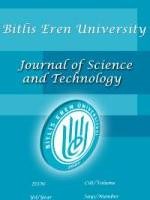Some plant extracts that prevent lipid peroxidation and protect the unsaturated fatty acids in the fenton reagent environment
Some plant extracts that prevent lipid peroxidation and protect the unsaturated fatty acids in the fenton reagent environment
Antioxidant capacity, A. italicum, L. nobilis, Lipid peroxidation, M. sylvestris,
___
- Barros L, Carvalho AM, Ferreira ICFR (2010). Leaves, flowersi immature fruits and leafy flowered stems of Malva sylvestris: A comparative study of the nutraceutical potential and composition. Food Chem Tox 48, 1466-1472.
- Brand-Williams W, Cuvelier ME, Berset C (1995). Use of a free radical method to evaluate antioxidant activity. Lebensm Wiss Technol 28, 25-30.
- Chatterjee N, Agarwal S (1988). Liposomes as membrane model for study of lipid peroxidation. Free Radic Biol Med 4, 51-72.
- Chen CC, Liu LK, Hsu JD, Huang HP, Yang MY, Wang CJ (2005). Mulberry extract inhibits the development of atherosclerosis in cholesterol-fed rabbits. Food Chem 91, 601-607.
- Christie WW (1992). Gas chromatography and lipids. Glaskow: The Oil Pres.
- Conforti F, Statti G, Uzunov D, Menichini F (2006). Comparative chemical composition and antioxidant activities of wild and cultivated Laurus nobilis L. leaves and Foeniculum vulgare subsp. piperitum (Ucria) coutinho seeds. Biol Pharma Bull 29, 2056-2064.
- Conforti F, Sosa S, Marrelli M, Menichini F, Statti GA, Uzunov D, Tubaro A, Menichini F, Loggia RD (2008). In vivo anti-inflammatory and in vitro antioxidant activities of Mediterranean dietary plants. J Ethnopharmacol 116, 144-151.
- De Las Heras A, Schoch A, Gibis M, Fischer A (2003). Comparison malondialdehyde in dry sausage by HPLC and the classic TBA test. Eur Food Res Tech 217, 80-184.
- DellaGreca M, Cutillo F, D’ Abrosca B, Fiorentino A, Pacifico S, Zarrelli A (2009). Antioxidant and radical scavenging properties of Malva sylvestris. Nat Prod 4, 893-896.
- Derwich E, Benziane Z, Boukir A (2009). Chemical composition and antibacterial activity of leaves essential oil of Laurus nobilis from Morocco. Aust J Basic Appl Sci 3, 3818-3824.
- Fejes S, Blazovics A, Lemberkovics E, Petri G, Szoke E, Kery A (2000). Free radical scavenging and membrane protective effects of methanol extracts from Anthriscus cerefolium L. (Hoffm.) and Petroselinum crispum (Mill.) Nym. Ex A W Hill. Phyto Res 14, 362-365.
- Kang HW, Yu KW, Jun WJ, Chang IS, Han SB, Kim HY, Cho HY (2002). Isolation and characterization of alkyl peroxy radical scavenging compound from leaves Laurus nobilis. Biol Pharma Bull 25, 102-108.
- Kaurinovic B, Popovic M, Vlaisavljevic S (2010). In vitro and in vivo effects of Laurus nobilis L. leaf extracts. Molecules 15, 3378-3390.
- Kris-Etherton PM, Lefevre M, Beecher GR, Gross MD, Keen CL, Etherton TD (2004). Bioactive compounds in nutrition and health-research methodologies for establishing biological funtion: the antioxidant and anti-inflammatory atherosclerosis. Ann Review Nutr 24, 511-538. of flavonoids on macrophages:
- Ozsahin AD, Yilmaz O (2010). Fruit sugar, flavonoid and phytosterol contents of apricot fruits (Prunus armeniaca L. Kabasi) and antioxidant effects in the free radicals environment. Asian J Chem 22, 6403- 6412.
- Ozsahin AD, Yilmaz O, Tuzcu M, Kireci OA, Guvenc M (2010). Radical scavenging activities of some Vitis vinifera varieties grown in Malatya (Turkey) and their preventive effects on theformation lipid peroxidation unsaturated fatty acid mediated. Asian J Chem 10, 7939-7948.
- Papageorgiou V, Mallouchos A, Komaitis M (2008). Investigation of the antioxidant behavior of air and freze dried aromatic plant materials in relation to their phenolic content and vegetative cycle. J Agric Food Chem 56, 5743-5752.
- Pech B, Bruneton J (1982). Alkaloids of Laurus nobilis. J Nat Prod 45, 560-563.
- Politeo O, Jukic M, Milos M (2007). Chemical composition and antioxidant activity of free volatile aglycones from bay (Laurus nobilis L.) compared to its essential oil. Croat Chem Acta 80, 121-126.
- Robak J, Gryglewski J (1988). Flavonoids are scavengers of superoxide anion. Biochem Pharma 37, 837-841.
- Roberfroid M, Colderon PB (1995). Free Radicals and Oxidation Phenomena in Biological Systems, eds. Roberfroid M, Colderon PB, University of Catholique de Louvain Brussels, New York, pp. 11-32.
- Saleem A, Husheem M, Harkonen P, Pihlaja K (2002). Inhibition of cancer cell growth by crude extract and the phenolics of Terminalia chebula retz. fruit. J Ethnopharmacol 81, 327-336.
- Saglık S, Alpınar K, Imre S (2002). Fatty acid composition of the seed oil of Arum italicum Miller. J Food Lipids 9, 95-103.
- Shahidi F, Marian N (2003). Phenolics in Food and Nutraceuticals, CRS Presss LLC, Boca Raton, FL, pp. 144-150.
- Shimoi K, Masuda S, Furugori M., Esaki S, Kinae N (1994). Radioprotective effect of antioxidative flavonoids in γ- ray-irradiated mice. Carcinogenesis 15, 2669-2672.
- Sichel G, Corsaro C, Scalia M, Dibilio J, Bonomo R (1991). In vitro scavenger activity of some flavonoids and melanins against O2. Free Radic Biol Med 11, 1-8.
- Skerget M, Kotnik P, Hadolin M., Hras AR, Simonic M, Knez Z (2005). Phenols, proanthocyanidins, flavones and flavonols in some plant materials and their antioxidant activities. Food Chem 89, 191-198.
- Vidal-Ollivier E, Elias R, Faure F, Babafjamian A, Crespin F, Balansard G, Boudon G (1989). Flavonal glycosides from Calendula officinalis flowers. Planta Med 55, 73- 74.
- Zhang Y, Vareed SK, Nair MG (2005). Human tumor cell growth inhibition by non-toxic anthocyanidins, the pigments in fruits and vegetables. Life Sci 76, 1465- 1472.
- Yayın Aralığı: Yılda 2 Sayı
- Başlangıç: 2011
- Yayıncı: Bitlis Eren Üniversitesi
The farm animal genetic resources of Turkey: sheep – II – crossbreed and extinct genotypes/breeds
Orhan YILMAZ, Richard Trevor WİLSON, Fırat CENGİZ, Mehmet ERTUĞRUL
A novel algorithm for computer based assessment
Molecular dynamics simulation of crystallization of amorphous aluminium modelled with EAM
Ayse Dilek OZSAHİN, Oguz Ayhan KİRECCİ, Zehra GOKCE, Gulcan BALCİ, Okkes YİLMAZ
The gross alpha and beta radioactivity concentration on the Sivrice (Elazığ) fault zone
